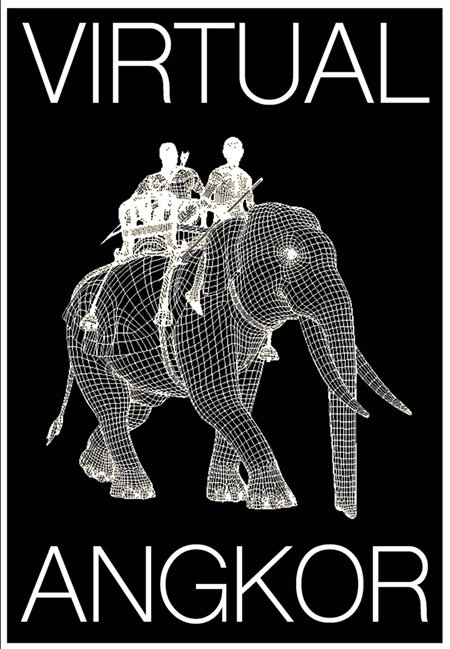Sources
Any reconstruction of Angkor starts from the limited source base which provides the historical scaffolding for the virtual project. These sources fit broadly into five categories. First, there are the Sanskrit and Old Khmer inscriptions, which offer a glimpse into the political, economic, and social life of city. Almost 1,300 Sanskrit and ancient Khmer inscriptions in stone have been found in territories that were once claimed by the Khmer empire. This body of inscriptions attests to the existence of an expansive corpus of scientific, educational, historical, epic, and religious literature (Jacques 2002), but the vast majority of the texts that once circulated on the perishable sheaves of the fan-palm leaf (Borassus flabellifer) no longer survive. Second, historians rely on European, especially French, accounts of nineteenth-century Cambodia. These include early sketches and photographs of the structures and the wider environment. Third, Angkor is famous for the remarkable bas-reliefs in the Bayon at Angkor Thom and at Angkor Wat itself, which provide detailed visual depictions. Fourth are the eyewitness accounts of Zhou Daguan, a Chinese official dispatched to Angkor in 1296 by the Temur Emperor, who produced an account of the city and its inhabitants. Finally, there is contemporary archaeological research on Angkor, including airborne surveys and the extensive mapping of Angkor carried out by the École français d’Extrême-Orient (French School of the Far East, EFEO) and the Greater Angkor Project. In addition to these five broad categories of sources, the project draws broadly on architectural surveys, botanical and palynological research, textile studies, and the work of ethnomusicologists.
Bibliography
For those interested in delving further into the history of Angkor and the Khmer Empire, take a look at the following resources:
Online:
- To see the latest developments in archaeological research on Angkor, visit the University of Sydney’s Angkor Research Program.
- Trek through the Temples of Angkor from the comfort of your own home via Google Maps Street View.
- Damian Evans, Christophe Pottier, Roland Fletcher, Scott Hensley, Ian Tapley, Anthony Milne and Michael Barbetti, “A comprehensive archaeological map of the world's largest preindustrial settlement complex at Angkor, Cambodia,” Proceedings of the National Academy of the Sciences of the United States of America 104, no. 36 (2007): 14227-14282. https://doi.org/10.1073/pnas.0702525104
The most extensive exploration of the geography of Angkor, which was developed through a combination of decades of on-the-ground mapping surveys with cutting-edge remote-sensing technologies developed in conjunction with the Jet Propulsion Laboratory and NASA.
- Brendan M. Buckley, Kevin J. Anchukaitis, Daniel Penny, Roland Fletcher, Edward R. Cook, Masaki Sano, Le Canh Nam, Aroonrut Wichienkeeo, Ton That Minh and Truong Mai Hong, “Climate as a contributing factor in the demise of Angkor, Cambodia,” Proceedings of the National Academy of the Sciences of the United States of America 107, no. 15 (2010): 6748-6752. https://doi.org/10.1073/pnas.0910827107
A detailed and fascinating scientific examination of the role played by climate change in the eventual collapse of Angkor and the Khmer Empire in the 13th century.
- Roland Fletcher, Damian Evans, Christophe Pottier, Chhay Rachna, “Angkor Wat: An Introduction,” Antiquity 89, no. 348 (2015): 1388-1401. https://doi.org/10.15184/aqy.2015.178
A brilliant introduction to a special series of articles dedicated to exploring the latest developments in archaeological research on Angkor Wat and its surrounds.
Print:
- Zhou Daguan, A Record of Cambodia, The Land and Its People, trans. Peter Harris (Chiang Mai, Thailand: Silkworm Books, 2007).
The latest and most accurate translation of the Chinese imperial envoy Zhou Daguan’s visit to Cambodia in the late 13th century.
- George Cœdès, Angkor: An Introduction (Hong Kong: Oxford University Press, 1963)
A historically significant account of Angkor as written by one of the leading French scholars of Southeast Asia of the 20th century.
- David Chandler, A History of Cambodia, 4th Edition (Boulder, Colorado: Westview Press, 2008).
The definitive general history book on Cambodia from ancient times to the 21st century written by the foremost scholar in the field.
- Ian William Mabbett and David Chandler, The Khmers (Silkworm Books, 1996).
An authoritative monograph covering 2,000 years of the Khmer people and their culture as produced by the two greatest historians of ancient and modern Cambodian history.
- Michael D. Coe, Angkor and the Khmer Civilization (London: Thames & Hudson, 2003).
A concise survey of Cambodian history from the beginning of recorded Khmer history to the expansion of French colonialism into Cambodia in the 18th century.
- John Burgess, A Woman of Angkor (New York: River Books, 2013).
A critically-acclaimed historical fiction novel set in the courts and temples of 12th century Angkor.

